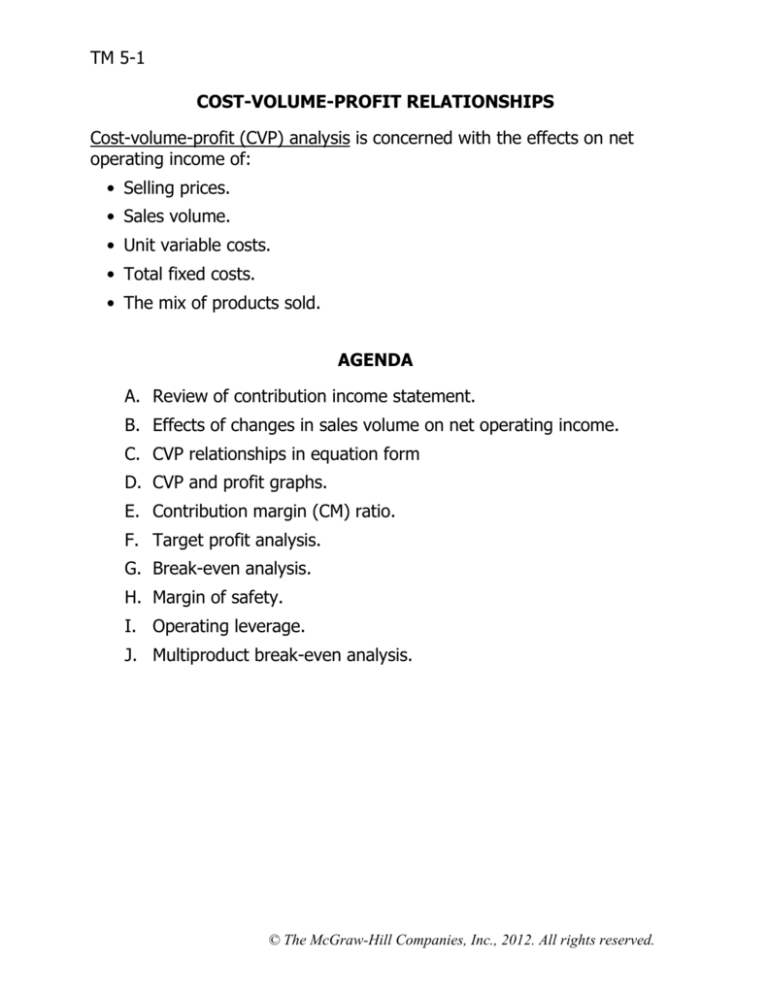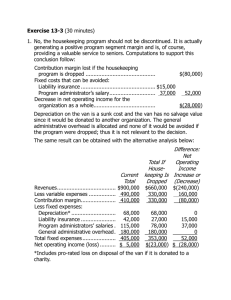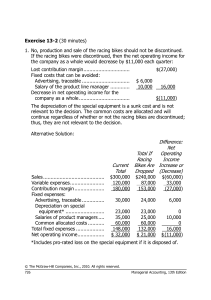
TM 5-1
COST-VOLUME-PROFIT RELATIONSHIPS
Cost-volume-profit (CVP) analysis is concerned with the effects on net
operating income of:
• Selling prices.
• Sales volume.
• Unit variable costs.
• Total fixed costs.
• The mix of products sold.
AGENDA
A. Review of contribution income statement.
B. Effects of changes in sales volume on net operating income.
C. CVP relationships in equation form
D. CVP and profit graphs.
E. Contribution margin (CM) ratio.
F. Target profit analysis.
G. Break-even analysis.
H. Margin of safety.
I. Operating leverage.
J. Multiproduct break-even analysis.
© The McGraw-Hill Companies, Inc., 2012. All rights reserved.
TM 5-2
THE CONTRIBUTION APPROACH
A contribution format income statement is very useful in CVP analysis
because it highlights cost behavior.
EXAMPLE: Last month’s contribution income statement for Nord
Corporation, a manufacturer of exercise bicycles, follows:
Sales (500 bikes) ...........
Variable expenses ..........
Contribution margin .......
Fixed expenses ..............
Net operating income.....
Total
$250,000
150,000
100,000
80,000
$ 20,000
Per Unit
$500
300
$200
CONTRIBUTION MARGIN:
• The amount that sales (net of variable expenses) contributes toward
covering fixed expenses and then toward profits.
• The unit contribution margin remains constant so long as the selling
price and the unit variable cost do not change.
© The McGraw-Hill Companies, Inc., 2012. All rights reserved.
TM 5-3
VOLUME CHANGES AND NET OPERATING INCOME
Contribution income statements are given on this and the following page
for monthly sales of 1, 2, 400, and 401 bikes.
Sales (1 bike) ......................
Variable expenses ................
Contribution margin .............
Fixed expenses ....................
Net operating income (loss) ..
Sales (2 bikes) .....................
Variable expenses ................
Contribution margin .............
Fixed expenses ....................
Net operating income (loss) ..
$
Total
Per Unit
Total
Per Unit
500
300
200
80,000
$(79,800)
$ 1,000
600
400
80,000
$(79,600)
$500
300
$200
$500
300
$200
Note the following points:
1.
The contribution margin must first cover the fixed expenses. If it
doesn’t, there is a loss.
2.
As additional units are sold, fixed expenses are whittled down until
they have all been covered.
© The McGraw-Hill Companies, Inc., 2012. All rights reserved.
TM 5-4
VOLUME CHANGES AND NET OPERATING INCOME (continued)
Sales (400 bikes) ...................
Variable expenses ..................
Contribution margin ...............
Fixed expenses ......................
Net operating income (loss)....
Sales (401 bikes) ...................
Variable expenses ..................
Contribution margin ...............
Fixed expenses ......................
Net operating income (loss)....
Total
Per Unit
Total
Per Unit
$200,000
120,000
80,000
80,000
$
0
$200,500
120,300
80,200
80,000
$
200
$500
300
$200
$500
300
$200
Note the following points:
1.
If the company sells exactly 400 bikes a month, it will just break even
(no profit or loss).
2.
The break-even point is:
• The point where total sales revenue equals total expenses (variable
and fixed).
• The point where total contribution margin equals total fixed
expenses.
3.
Each additional unit sold increases net operating income by the
amount of the unit contribution margin.
© The McGraw-Hill Companies, Inc., 2012. All rights reserved.
TM 5-5
CVP RELATIONSHIPS IN EQUATION FORM
Terry’s Way shown in class:
Sales = Variable + Fixed + Net income
$500X = $300X + $80,000 + $0
$200X = $80,000
$200X = $80,000
$200
$200
X = 400 bicycles @break even
Sales = Variable + Fixed + Net income
$500X = $300X + $80,000 + $70,000
$200X = $150,000
$200X = $150,000
$200
$200
X = 750 bicycles @break even + $70,000 profit
© The McGraw-Hill Companies, Inc., 2012. All rights reserved.
TM 5-6
Garrison Textbook Way:
The contribution format income statement can be expressed in equation
form as follows:
Profit = (Sales − Variable expense) − Fixed expense
When a company has a single product, we can further refine the
equation as follows:
Profit = (P × Q − V × Q) − Fixed expense
EXAMPLE: This equation can be used to compute Nord Company’s net
operating income if it sells 401 bikes:
Profit = ($500 × 401 − $300 × 401) − $80,000
= ($500 − $300) × 401 − $80,000
= ($200) × 401 − $80,000
= $80,200 − $80,000 = $200
It is often useful to express the simple profit equation in terms of the
unit contribution margin as follows:
Profit = Unit CM × Q − Fixed expense
This equation can also be used to compute Nord Company’s net
operating income if it sells 401 bikes:
Profit = $200 × 401 − $80,000
Profit = $80,200 − $80,000 = $200
© The McGraw-Hill Companies, Inc., 2012. All rights reserved.
TM 5-7
PREPARING A CVP GRAPH
© The McGraw-Hill Companies, Inc., 2012. All rights reserved.
TM 5-8
THE COMPLETED CVP GRAPH
© The McGraw-Hill Companies, Inc., 2012. All rights reserved.
TM 5-9
Profit
THE PROFIT GRAPH
$40,000
$35,000
$30,000
$25,000
$20,000
$15,000
$10,000
$5,000
$0
-$5,000
-$10,000
-$15,000
-$20,000
-$25,000
-$30,000
-$35,000
-$40,000
-$45,000
-$50,000
-$55,000
-$60,000
-$65,000
-$70,000
-$75,000
-$80,000
-$85,000
-$90,000
0
75
150
225
300
375
450
525
600
Volume in bikes sold
Notice, the straight line goes through two data points at (0, -$80,000)
and (525, $25,000). The break-even point is denoted by the dotted line
at 400 bikes.
© The McGraw-Hill Companies, Inc., 2012. All rights reserved.
TM 5-10
CONTRIBUTION MARGIN RATIO
The contribution margin (CM) ratio is the ratio of contribution margin to
total sales:
CM ratio=
Contribution margin
Total sales
If the company has only one product, the CM ratio can also be computed
using per unit data:
CM ratio=
Unit contribution margin
Unit selling price
EXAMPLE: For Nord Corporation, the CM ratio is 40%, computed as
follows:
CM ratio=
Contribution margin $100,000
=
=40%
Total sales
$250,000
or
CM ratio=
Unit contribution margin $200 per unit
=
=40%
Unit selling price
$500 per unit
The relation between profit and the CM ratio can also be expressed using
the following equation:
Profit = CM ratio × Sales − Fixed expense
EXAMPLE: Nord Company’s profit if it sells 401 bikes can be computed as
follows:
Profit = 0.40 × $200,500 − $80,000
Profit = $80,200 − $80,000 = $200
© The McGraw-Hill Companies, Inc., 2012. All rights reserved.
TM 5-11
CONTRIBUTION MARGIN RATIO (continued)
The CM ratio shows how the contribution margin will be affected by a given
change in total sales.
EXAMPLE: Assume that Nord Corporation’s sales increase by $150,000 next
month. What will be the effect on (1) the contribution margin and (2) net
operating income?
(1)
Effect on contribution margin:
Increase in contribution margin = Increase in sales × CM ratio
= $150,000 × 40% = $60,000
(2)
Effect on net operating income:
If fixed expenses do not change, the net operating income for the month
will also increase by $60,000.
Sales (in units) ...............
Sales (in dollars) .............
Variable expenses ...........
Contribution margin ........
Fixed expenses ...............
Net operating income......
Present
500
$250,000
150,000
100,000
80,000
$ 20,000
Expected
800
$400,000
240,000
160,000
80,000
$ 80,000
Change
300
$150,000
90,000
60,000
0
$ 60,000
© The McGraw-Hill Companies, Inc., 2012. All rights reserved.
TM 5-12
TARGET PROFIT ANALYSIS
Summary of Nord Corporation Data:
Per Bike Percent
Selling price .........................
Variable expenses ................
Contribution margin .............
Fixed expenses ....................
$500
300
$200
100%
60%
40%
Per Month
$80,000
EXAMPLE: Assume that Nord Corporation’s target profit is $70,000 per
month. How many exercise bikes must it sell to reach this goal?
EQUATION METHOD (Unit sales)
Q = Number of bikes to attain the target profit
Profit = Unit CM × Q – Fixed Expenses
$70,000 = $200 × Q – $80,000
Q = 750 Bikes
EQUATION METHOD (Sales dollars)
What if Nord wanted to know how much sales revenue needed to be
generated to achieve a target profit of $70,000? We can compute the
answer two ways. First, we can multiply the answer from above by the
selling price per bike:
750 bikes × $500 per bike = $375,000
Or, we can use the following equation:
Profit = CM ratio × Sales – Fixed Expenses
$70,000 = 0.40 × Sales – $80,000
Sales = $375,000
© The McGraw-Hill Companies, Inc., 2012. All rights reserved.
TM 5-13
TARGET PROFIT ANALYSIS (continued)
Summary of Nord Corporation Data:
Per Bike Percent
Selling price .........................
Variable expenses ................
Contribution margin .............
Fixed expenses ....................
$500
300
$200
100%
60%
40%
Per Month
$80,000
EXAMPLE: Assume that Nord Corporation’s target profit is $70,000 per
month. How many exercise bikes must it sell to reach this goal?
FORMULA METHOD (Unit sales)
Target profit + Fixed expense
Unit sales to
=
attain a target profit
Unit CM
$70,000 + $80,000
Unit sales to
=
= 750 bikes
attain a target profit
$200 per bike
FORMULA METHOD (Dollar sales)
What if Nord wanted to know how much sales revenue needed to be
generated to achieve a target profit of $70,000? We can use the
following formula to derive the answer:
Dollar sales to = Target profit + Fixed expense
breakeven
CM ratio
Dollar sales to = $70,000 + $80,000 =$200,000
breakeven
0.40
© The McGraw-Hill Companies, Inc., 2012. All rights reserved.
TM 5-14
BREAK-EVEN ANALYSIS
Summary of Nord Corporation Data:
Per Bike Percent
Selling price .........................
Variable expenses ................
Contribution margin .............
Fixed expenses ....................
$500
300
$200
100%
60%
40%
Per Month
$80,000
EXAMPLE: Using the equation method, we can compute Nord Company’s
break-even point in unit sales as follows:
EQUATION METHOD (Unit sales)
Profit = Unit CM × Q – Fixed expense
$0 = $200 × Q – $80,000
$200 × Q = $0 +$80,000
Q = ($0 + $80,000) ÷ $200
Q = 400 bikes
EXAMPLE: Using the equation method, we can compute Nord Company’s
break-even point in dollar sales as follows:
EQUATION METHOD (Dollar sales)
Profit = CM ratio × Sales – Fixed Expenses
$0 = 0.40 × Sales – $80,000
0.40 × Sales = $0 + $80,000
Sales = ($0 +$80,000) ÷ 0.40
Sales = $200,000
© The McGraw-Hill Companies, Inc., 2012. All rights reserved.
TM 5-15
BREAK-EVEN ANALYSIS (continued)
Summary of Nord Corporation Data:
Per Bike Percent
Selling price .........................
Variable expenses ................
Contribution margin .............
Fixed expenses ....................
$500
300
$200
100%
60%
40%
Per Month
$80,000
EXAMPLE: Using the formula method, we can compute Nord Company’s
break-even point in unit sales as follows:
FORMULA METHOD (Units sales)
Unit sales to = Fixed expense
breakeven
Unit CM
Unit sales to = $80,000 =400 bikes
breakeven $200 per bike
FORMULA METHOD (Dollar sales)
EXAMPLE: Using the formula method, we can compute Nord Company’s
break-even point in dollar sales as follows:
Dollar sales to = Fixed expense
breakeven
CM ratio
Dollar sales to = $80,000 =$200,000
breakeven
0.40
© The McGraw-Hill Companies, Inc., 2012. All rights reserved.
TM 5-16
MARGIN OF SAFETY
The margin of safety is the excess of budgeted (or actual) sales over the
break-even sales. The margin of safety can be expressed either in dollar or
percentage form. The formulas are:
Margin of safety =Total sales-Breakeven sales
in dollars
Margin of safety = Margin of safety in dollars
percentage
Total sales
Sales ....................................
Variable expenses ..................
Contribution margin ...............
Fixed expenses ......................
Net operating income ............
Break-even point:
$90,000 ÷ 0.30 ...................
$340,000 ÷ 0.80 .................
Margin of safety in dollars:
$500,000 – $300,000 ..........
$500,000 – $425,000 ..........
Margin of safety percentage:
$200,000 ÷ $500,000..........
$75,000 ÷ $500,000 ...........
Company X
$500,000
350,000
150,000
90,000
$ 60,000
$300,000
$200,000
100%
70%
30%
Company Y
$500,000
100,000
400,000
340,000
$ 60,000
100%
20%
80%
$425,000
$75,000
40%
15%
© The McGraw-Hill Companies, Inc., 2012. All rights reserved.
TM 5-17
OPERATING LEVERAGE
Operating leverage measures how a given percentage change in sales
affects net operating income.
Contribution margin
Degree of
=
operating leverage Net operating income
Sales ....................................
Variable expenses ..................
Contribution margin ...............
Fixed expenses ......................
Net operating income ............
Company X
$500,000 100%
350,000 70%
150,000 30%
90,000
$ 60,000
Degree of operating leverage .
2.5
Company Y
$500,000 100%
100,000 20%
400,000 80%
340,000
$ 60,000
6.7
If the degree of operating leverage is 2.5, then a 10% increase in sales
should result in a 25% (= 2.5 × 10%) increase in net operating income.
EXAMPLE: Assume that both company X and company Y experience a 10%
increase in sales:
Sales ..........................................
Variable expenses ........................
Contribution margin .....................
Fixed expenses ............................
Net operating income ..................
Increase in net operating income..
Company X
$550,000 100%
385,000 70%
165,000 30%
90,000
$ 75,000
25%
Company Y
$550,000 100%
110,000 20%
440,000 80%
340,000
$100,000
67%
© The McGraw-Hill Companies, Inc., 2012. All rights reserved.
TM 5-18
OPERATING LEVERAGE (continued)
The degree of operating leverage is not constant—it changes with the
level of sales.
EXAMPLE: At the higher level of sales, the degree of operating leverage for
Company X decreases from 2.5 to 2.2 and for Company Y from 6.7 to 4.4.
Sales ........................................
Variable expenses .....................
Contribution margin ..................
Fixed expenses .........................
Net operating income ................
Degree of operating leverage.....
Company X
(000s)
Company Y
(000s)
$500 $550
350 385
150 165
90
90
$ 60 $ 75
$500 $550
100 110
400 440
340 340
$ 60 $100
2.5
2.2
6.7
4.4
Ordinarily, the degree of operating leverage declines as sales increase.
© The McGraw-Hill Companies, Inc., 2012. All rights reserved.
TM 5-19
MULTIPRODUCT BREAK-EVEN ANALYSIS
When a company has multiple products, the overall contribution margin (CM) ratio is used in breakeven analysis.
Overall CM ratio=
Total contribution margin
Total sales dollars
Sales ...........................
Variable expenses .........
Contribution margin ......
Fixed expenses .............
Net operating income ...
Product A
Product B
$100,000 100%
70,000 70%
$ 30,000 30%
$300,000 100%
120,000 40%
$180,000 60%
Overall CM ratio=
Total contribution margin $210,000
=
=52.5%
Total sales dollars
$400,000
Breakeven sales=
Fixed expenses $141,750
=
=$270,000
Overall CM ratio
0.525
Total
$400,000
190,000
210,000
141,750
$ 68,250
100.0%
47.5%
52.5%
© The McGraw-Hill Companies, Inc., 2012. All rights reserved.
TM 5-20
MULTIPRODUCT BREAK-EVEN ANALYSIS (continued)
The relative proportions in which the products are sold is called the sales mix. If the sales mix
changes, the overall contribution margin ratio will change.
Example: Assume that total sales remain unchanged at $400,000. However, the sales mix shifts so that
more of Product A is sold than of Product B.
Sales ...........................
Variable expenses .........
Contribution margin ......
Fixed expenses .............
Net operating income ...
Product A
Product B
$300,000 100%
210,000 70%
$ 90,000 30%
$100,000 100%
40,000 40%
$ 60,000 60%
Overall CM ratio=
Total contribution margin $150,000
=
=37.5%
Total sales dollars
$400,000
Breakeven sales=
Fixed expenses $141,750
=
=$378,000
Overall CM ratio
0.375
Total
$400,000
250,000
150,000
141,750
$ 8,250
100.0%
62.5%
37.5%
© The McGraw-Hill Companies, Inc., 2012. All rights reserved.
TM 5-21
MAJOR ASSUMPTIONS OF CVP ANALYSIS
1.
Selling price is constant. The price does not change as volume
changes.
2.
Costs are linear and can be accurately split into fixed and
variable elements. The total fixed cost is constant and the
variable cost per unit is constant.
3.
The sales mix is constant in multi-product companies.
4.
In manufacturing companies, inventories do not change. The
number of units produced equals the number of units sold.
© The McGraw-Hill Companies, Inc., 2012. All rights reserved.









